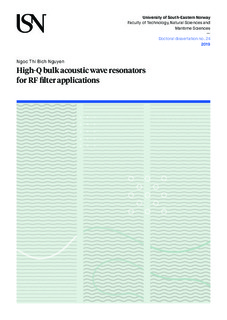| dc.contributor.author | Nguyen, Ngoc Thi Bich | |
| dc.date.accessioned | 2019-02-07T14:14:29Z | |
| dc.date.available | 2019-02-07T14:14:29Z | |
| dc.date.issued | 2019 | |
| dc.identifier.isbn | 978-82-7860-347-5 | |
| dc.identifier.issn | 2535-5252 | |
| dc.identifier.uri | http://hdl.handle.net/11250/2584418 | |
| dc.description.abstract | This thesis proposes a novel design method for optimizing bulk acoustic wave (BAW) resonators, including film bulk acoustic resonators (FBAR) and solidly mounted res-onators (SMR). The purpose is to enhance their quality factors Q at the frequencies of interest. These resonators are targeted for the filters in the radio frequency (RF) front-end module of mobile devices. The significant losses at such high frequencies make the optimization more challenging. In the present work, acoustic loss induced by lateral leakage of Lamb waves in an FBAR or generalized Lamb waves in an SMR is alleviated to obtain a high Q factor at its antiresonance frequency. This is done by systematically modifying the resonator geometry. A dual-step frame placed atop the periphery region of a resonator serves as a lateral Bragg reflector. Each step of this frame is considered as a “mirror layer” of the reflector. Laterally propagating waves once encountering this reflector bounce back into the resonator. These waves are inhibited from escaping to the outside area and their energy is thus confined within the resonator’s active region. The key feature of the proposed frame is its ability to reflect the two wave modes that carry the largest energy. Accordingly, the step widths are calculated by means of the diffraction grating method that was previously recommended for the Bragg reflector of an SMR in literature. The step heights are estimated so that sufficient acoustic impedance mismatches are created between the non-frame regions and the step, and between the two steps. Since these computations require insight about lateral waves propagating in a BAW resonator, the characteristics of these waves in a mixed-multilayer stack of non-piezoelectric and piezoelectric materials are studied. Both Finite element method (FEM) sim-ulations and matrix methods are utilized to determine the phase velocities of the waves, mode shapes, energy carried by each mode and acoustic impedance of each resonator region. FEM simulations are then used to evaluate the operation and performance of all the designed resonators.
The inclusion of more filters in modern RF front-end modules with limited areas suggests the device miniaturization. The impact of a reduced area on the working frequencies and performance of BAW resonators is thus investigated. As the area shrinks, the significance of lateral edge contribution to the main resonance is more prominent. The effects of a micro variation in the resonator area on its Q factor at antiresonance frequency are also determined. This finding provides an essential guideline to designing the resonators using 2D FEM simulations.
The SMR-type resonators of three different non-framed designs are fabricated and measured to demonstrate the impact of a resonator size and shape on its perfor-mance. The (vertical) Bragg reflectors of these SMRs are designed to reflect both longitudinal and shear waves. The samples are fabricated in a consecutive sequence so that the later one can overcome the problems faced by its former one. | nb_NO |
| dc.language.iso | eng | nb_NO |
| dc.publisher | University of South-Eastern Norway, Faculty of Technology, Natural Sciences and Maritime Sciences | nb_NO |
| dc.relation.ispartofseries | Doctoral dissertations at the University of South-Eastern Norway;24 | |
| dc.relation.haspart | 1. N. Nguyen, A. Johannessen, S. Rooth, and U. Hanke, “A design approach for high-Q FBARs with a dual step frame”, Transactions on Ultrasonics Fer-roelectrics and Frequency Control, vol. 65, 2018, pp. 1717–1725. | nb_NO |
| dc.relation.haspart | 2. N. Nguyen, A. Johannessen, S. Rooth, and U. Hanke, “The impact of area on BAW resonator performance and an approach to device miniaturization”, accepted to be published in Ultrasonics journal. | nb_NO |
| dc.relation.haspart | 3. N. Nguyen, S. Rooth, A. Johannessen, and U. Hanke, “Improvement of methods in analyzing the propagation of plate waves in FBARs” in 2016 IEEE International Frequency Control Symposium (IFCS), 2016, pp. 1–6. | nb_NO |
| dc.relation.haspart | 4. N. Nguyen, A. Johannessen, and U. Hanke, “Design of high-Q thin film bulk acoustic resonator using dual-mode reflection” in 2014 IEEE International Ultrasonics Symposium, 2014, pp. 487–490. | nb_NO |
| dc.relation.haspart | N. Nguyen, S. Rooth, A. Johannessen, and U. Hanke,“Geometrically op-timized FBAR elements for ladder type filter”, proceeding of International Workshop on Microwave Filters, CNES/ESA, 2015. | nb_NO |
| dc.rights | Navngivelse-Ikkekommersiell-DelPåSammeVilkår 4.0 Internasjonal | * |
| dc.rights | Navngivelse-Ikkekommersiell-DelPåSammeVilkår 4.0 Internasjonal | * |
| dc.rights.uri | http://creativecommons.org/licenses/by-nc-sa/4.0/deed.no | * |
| dc.title | High-Q bulk acoustic wave resonators for RF filter applications | nb_NO |
| dc.type | Doctoral thesis | nb_NO |
| dc.description.version | publishedVersion | nb_NO |
| dc.source.pagenumber | 100 | nb_NO |

